The NVIDIA GeForce GTX 750 Ti and GTX 750 Review: Maxwell Makes Its Move
by Ryan Smith & Ganesh T S on February 18, 2014 9:00 AM ESTPower, Temperature, & Noise
As always, last but not least is our look at power, temperature, and noise. Next to price and performance of course, these are some of the most important aspects of a GPU, due in large part to the impact of noise. All things considered, a loud card is undesirable unless there’s a sufficiently good reason – or sufficiently good performance – to ignore the noise.
| GeForce GTX 750 Series Voltages | ||||
| Ref GTX 750 Ti Boost Voltage | Zotac GTX 750 Ti Boost Voltage | Zotac GTX 750 Boost Voltage | ||
| 1.168v | 1.137v | 1.187v | ||
For those of you keeping track of voltages, you’ll find that the voltages for GM107 as used on the GTX 750 series is not significantly different from the voltages used on GK107. Since we’re looking at a chip that’s built on the same 28nm process as GK107, the voltages needed to drive it to hit the desired frequencies have not changed.
| GeForce GTX 750 Series Average Clockspeeds | |||||
| Ref GTX 750 Ti | Zotac GTX 750 Ti | Zotac GTX 750 | |||
| Max Boost Clock |
1150MHz
|
1175MHz
|
1162MHz
|
||
| Metro: LL |
1150MHz
|
1172MHz
|
1162MHz
|
||
| CoH2 |
1148MHz
|
1172MHz
|
1162MHz
|
||
| Bioshock |
1150MHz
|
1175MHz
|
1162MHz
|
||
| Battlefield 4 |
1150MHz
|
1175MHz
|
1162MHz
|
||
| Crysis 3 |
1149MHz
|
1174MHz
|
1162MHz
|
||
| Crysis: Warhead |
1150MHz
|
1175MHz
|
1162MHz
|
||
| TW: Rome 2 |
1150MHz
|
1175MHz
|
1162MHz
|
||
| Hitman |
1150MHz
|
1175MHz
|
1162MHz
|
||
| GRID 2 |
1150MHz
|
1175MHz
|
1162MHz
|
||
| Furmark |
1006MHz
|
1032MHz
|
1084MHz
|
||
Looking at average clockspeeds, we can see that our cards are essentially free to run at their maximum boost bins, well above their base clockspeed or even their official boost clockspeed. Because these cards operate at such a low TDP cooling is rendered a non-factor in our testbed setup, with all of these cards easily staying in the 60C or lower range, well below the 80C thermal throttle point that GPU Boost 2.0 uses.
As such they are limited only by TDP, which as we can see does make itself felt, but is not a meaningful limitation. Both GTX 750 Ti cards become TDP limited at times while gaming, but only for a refresh period or two, pulling the averages down just slightly. The Zotac GTX 750 on the other hand has no such problem (the power savings of losing an SMX), so it stays at 1162MHz throughout the entire run.

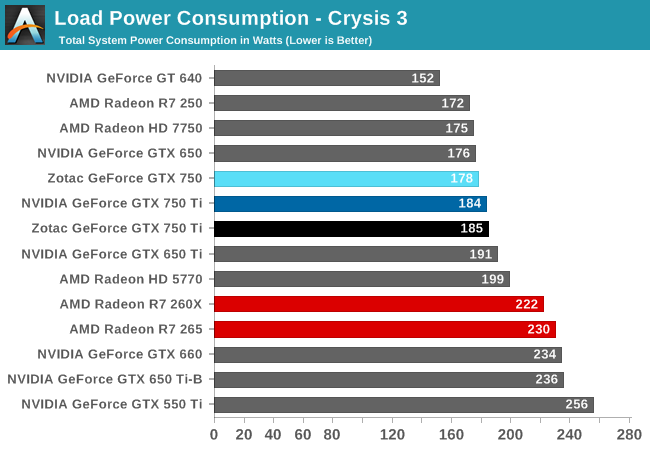
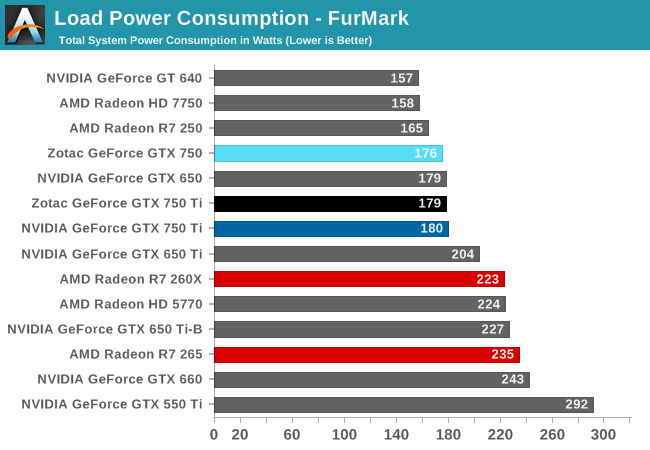


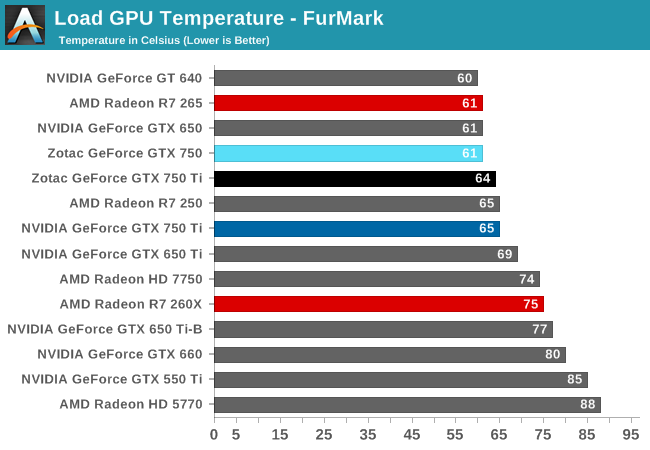
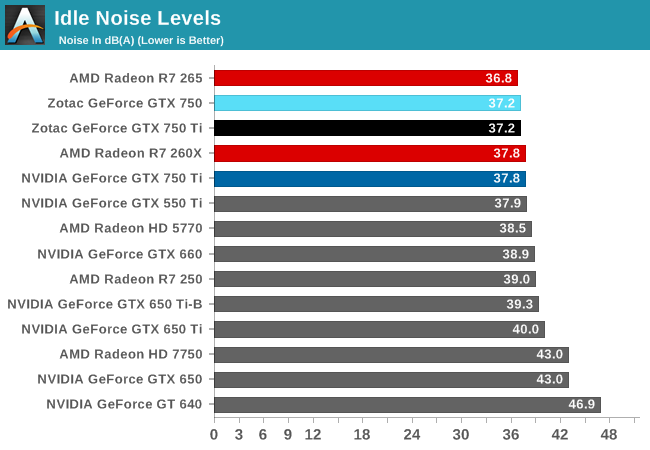
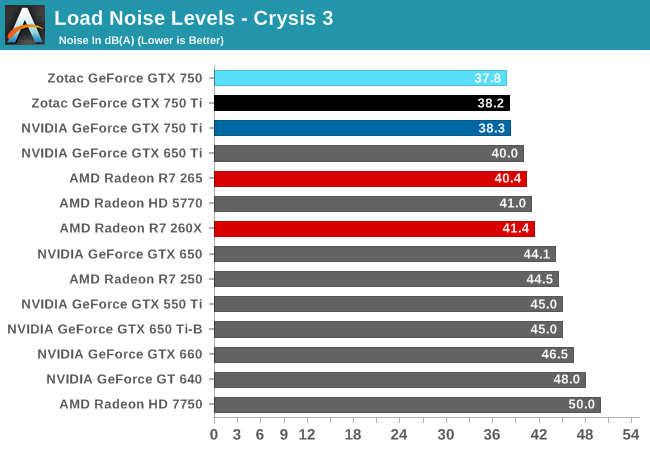
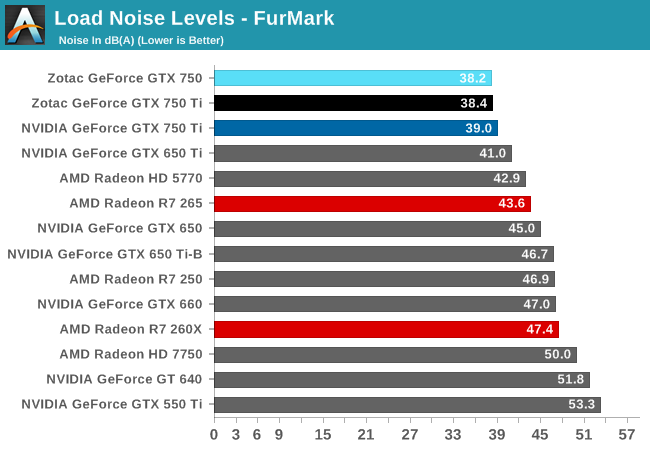










177 Comments
View All Comments
formulav8 - Tuesday, February 18, 2014 - link
Overall their drivers have been fine for a long time. NVidia and AMD run into bugs time to time. I'm sure you know NVidia has bugs as well. Just because you don't see them doesn't mean there are none and that NVidia is perfect.dgingeri - Wednesday, February 19, 2014 - link
yeah, well, I've never had bugs with my Nvidia cards to the degree of the bugs with my two AMD/ATI video cards. I had that 4870X2 for over a year and a half, quietly waiting for them to fix the bugs in the drivers to get it to properly use the second GPU, only to have them completely abandon me at the 10.1 driver and beyond.extide - Tuesday, February 18, 2014 - link
So, really, not even a single mention of Maxwell's marquee feature, "Unified Virtual Memory?" I think you guys got a little bit caught up in the power/watt increase, and entirely forgot about that!kwrzesien - Tuesday, February 18, 2014 - link
It will probably be unveiled with the 800 series cards. It might be baked into the die but not enabled in this revision or it might be there but not enabled in the drivers. What we want to wait for is the 860/880 which will have the muscle to do something amazing with UVM.jwcalla - Tuesday, February 18, 2014 - link
I don't think UVM will provide much in the way of benefits other than making some CUDA programming [marginally] easier.doubledeej - Tuesday, February 18, 2014 - link
Is anybody ever going to produce a decent single slot video card again? I'm getting a little tired of either having low-end, slow cards, or having all of my PCIe slots being covered up.DanNeely - Tuesday, February 18, 2014 - link
Probably not. Making a quiet card is much easier in a 2 slot form factor; and the number of people who care about performance and need the slot immediately below their GPU is a very small fraction of the total.On a tangent, legacy PCI is facing extinction because it's been removed from Intel's current chipsets and is only available via a bridge chip. If you have a long term need for it; I'd advise buying a current generation mobo with an unobstructed slot while they're still on the market.
TheinsanegamerN - Tuesday, February 18, 2014 - link
you mean like the geforce 680 single slot edition that never came out? yeah, I wish companies would actually make those things.FelixDraconis - Tuesday, February 18, 2014 - link
I really like the direction this card is going in. Especially if there's a DisplayPort variant coming. It's tough building a low power ITX system with DP without using onboard graphics.But what's up with the 750 name? That's just blatantly misleading, as the 760 has been out for almost a year now and is an older process, while originally Maxwell was slated to be called 8XX. Nothing new, but boy is this confusing. I guess it makes short term sense for marketing, as it always does.
jwcalla - Tuesday, February 18, 2014 - link
Obviously they're reserving the 800 series for the 20nm parts.